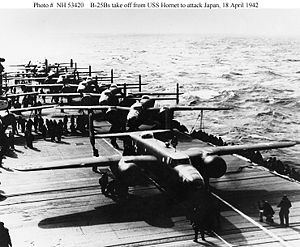Doolittle Raid: Difference between revisions
Jump to navigation
Jump to search
imported>Howard C. Berkowitz No edit summary |
imported>Howard C. Berkowitz |
||
| Line 1: | Line 1: | ||
==The operational concept== | ==The operational concept== | ||
[[Image:B25s waiting to take off on Doolittle Raid.jpg|thumb|300px|B-25 bombers awaiting takeoff on the raid]] | [[Image:B25s waiting to take off on Doolittle Raid.jpg|thumb|300px|B-25 bombers awaiting takeoff on the raid]] | ||
| Line 14: | Line 6: | ||
LTC [[James Doolittle]] was selected to lead the raid. | LTC [[James Doolittle]] was selected to lead the raid. | ||
Revision as of 09:14, 17 June 2009
The operational concept
No carrier-based aircraft of the time had the range to attack Japan from what was considered a safe striking distance. A concept was developed, probably originated by CAPT Francis Low of the Navy Staff, to launch U.S. Army medium bombers from a carrier. These bombers could not land on the carrier, but, with special procedures, could take off from one. The plan was that they would land in China after the raid, continuing west after they bombed Japan.
Two aircraft, the B-25 Mitchell and the B-26 Marauder, were available; the B-25 was selected because it needed less distance for takeoff.
LTC James Doolittle was selected to lead the raid.
